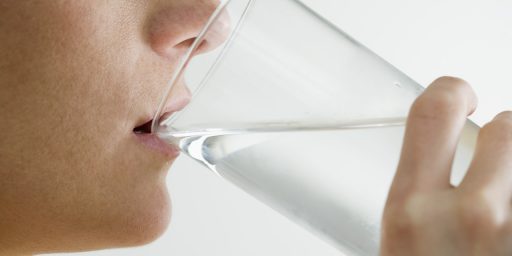Statehood Now!
WaPo: D.C. Homes Urged To Flush Taps Longer
District residents whose homes have lead service lines should flush their taps for 10 minutes to protect against high levels of lead in drinking water, according to new guidelines issued by authorities who said their previous recommendations of shorter flushing times were not effective.
Officials at the D.C. Water and Sewer Authority and the Environmental Protection Agency have agreed that the longer flushing time will ensure that water left in lead service lines overnight or for long periods is drained off before customers collect water for drinking or cooking.
WASA had previously distributed brochures and stated publicly that residents should flush their taps for about one or two minutes, a guideline based on long-standing EPA recommendations.
“The difficulty we have is that we have to un-educate people ,” WASA Deputy General Manager Michael Marcotte said last week. “We gave people a prescription from the EPA that said run taps for a minute and everything will be good. But quite possibly, if you follow that prescription, you will trade lower-lead water for higher-lead water. And we shouldn’t do that.”
The original guidelines were issued after residents and city leaders became outraged that WASA officials had delayed notifying the public about tests that revealed high levels of lead contamination in the tap water in thousands of District homes. Two-thirds of the 6,118 residences that WASA tested last summer, or 4,075 homes, had water that exceeded the lead limit of 15 parts per billion set by the EPA.
In most cases, EPA officials said, flushing for about one minute is long enough. That’s because lead in drinking water is most often caused by leaching from lead plumbing fixtures inside a home.
But in the District’s case, tests have shown that the lead is most likely leaching from lead service lines that run from the water main to the house. In fact, officials have discovered that in some homes the water that comes out of taps after one or two minutes of flushing often has higher lead levels than the water that comes out immediately after the tap is turned on. To address the problem, officials from WASA, the EPA’s mid-Atlantic office in Philadelphia and the D.C. Department of Health agreed on the new 10-minute flushing guideline in a conference call last week.
***
WASA officials suggest that the best way to flush the lines for 10 minutes is to take a shower and flush the toilet before drinking or cooking. That process will drain several gallons of water from the main pipes serving the homes.
Because each faucet in the house also has small amounts of standing water backed up, the residents should then run each faucet for another minute.
I’ve been in Third World countries that had drinkable tap water. And I didn’t have to take a shower and avail myself of the facilities first. It’s simply amazing that the nation’s capital, a rather affluent community even by U.S. standards, can’t meet even the most basic needs of its residents.






Doc, do you live in NoVa or DC itself? Bec with lead in those pipes and all it might be time to be a’movin. And to think you had to wait a year to get your deck set up too.
Fortunately, I’m in Loudoun County, where the water is quite drinkable.
Affluent or not, the DC government has proven many times over and under many different administrations that it is incapable of meeting the basic needs of its residents. Most notable is its public education system, which is worse than ineffective even though its teachers receive the highest average pay in the country. This is just the latest is a series of embarassing revelations.
(Personally, given the way the commuter tax argument is going, I think this could be part of a plot to raise DC revenue by increasing water usage!)
If I lived there, I’d drink only bottled water.
This is outrageous–though not shocking. (I’m a former dweller of a DC suburb, and I know. The corruption is palpable.)
The residents should be marching in the streets; the water is better in Tijuana!
—